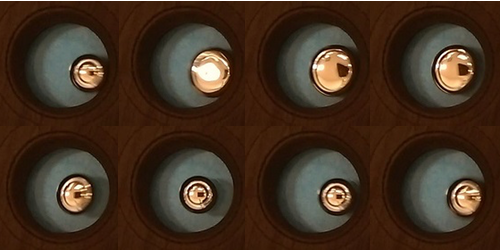Beat Strong, My Liquid Gallium Heart
Place an iron nail in the vicinity of a mercury drop and the drop will “beat” chaotically. The oscillations are driven by a chemical reaction that causes the drop’s surface tension to fluctuate so that the drop repeatedly flattens and balls up. While this motion is well known, researchers have struggled to gain control over the mercury drop’s chaotic beat, rendering it an academic curiosity. Now Xiaolin Wang from the University of Wollongong, Australia, and colleagues have shown that liquid gallium drops can also be made to oscillate via surface tension fluctuations. In addition, the periodicity of this oscillation can be precisely controlled using an electric current. The team says that their gallium “heart” could be used as a fluid-based timing device.
Wang and colleagues’ metal heart is basically a 50 gallium drop that bounces back and forth inside an electrified graphite ring. The team places the ring on an incline submerged in a conducting fluid and lets gravity pull the drop down. When the drop hits the ring’s inner wall, current flows through the drop and induces an oxidizing reaction on its outer surface. The oxidization both lowers the surface tension of the drop, causing it to flatten, and induces a repulsive electric force between the drop and ring. This force increases in strength as the drop spreads and ultimately pushes it back up the slope. Eventually, the oxidation process stops, and the drop recovers its initial spherical shape and repeats its downward voyage. The resulting gallium heart can run up and down the slope up to 610 times per minute, with the exact “beat rate” depending on the current.
This research is published in Physical Review Letters.
–Katherine Wright
Katherine Wright is a Senior Editor of Physics.





